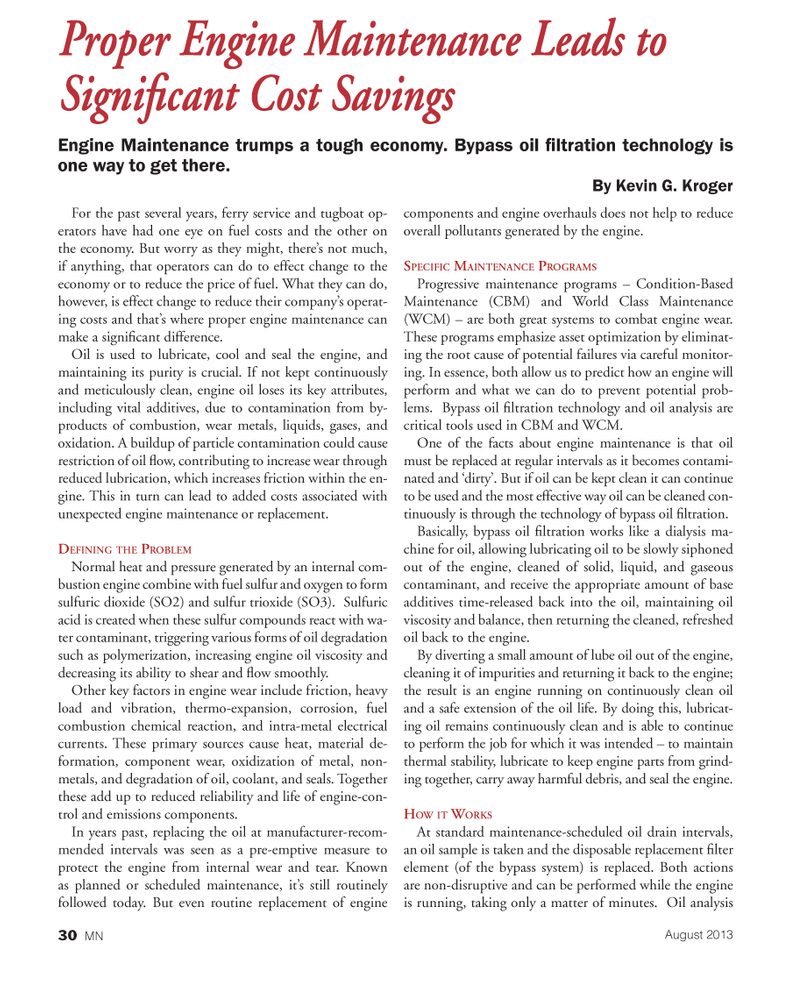
Page 30: of Marine News Magazine (August 2013)
Salvage & Response
Read this page in Pdf, Flash or Html5 edition of August 2013 Marine News Magazine
For the past several years, ferry service and tugboat op- erators have had one eye on fuel costs and the other on the economy. But worry as they might, theres not much, if anything, that operators can do to effect change to the economy or to reduce the price of fuel. What they can do, however, is effect change to reduce their companys operat- ing costs and thats where proper engine maintenance can make a signi? cant difference. Oil is used to lubricate, cool and seal the engine, and maintaining its purity is crucial. If not kept continuously and meticulously clean, engine oil loses its key attributes, including vital additives, due to contamination from by- products of combustion, wear metals, liquids, gases, and oxidation. A buildup of particle contamination could cause restriction of oil ? ow, contributing to increase wear through reduced lubrication, which increases friction within the en- gine. This in turn can lead to added costs associated with unexpected engine maintenance or replacement. DEFINING THE PROBLEM Normal heat and pressure generated by an internal com- bustion engine combine with fuel sulfur and oxygen to form sulfuric dioxide (SO2) and sulfur trioxide (SO3). Sulfuric acid is created when these sulfur compounds react with wa- ter contaminant, triggering various forms of oil degradation such as polymerization, increasing engine oil viscosity and decreasing its ability to shear and ? ow smoothly. Other key factors in engine wear include friction, heavy load and vibration, thermo-expansion, corrosion, fuel combustion chemical reaction, and intra-metal electrical currents. These primary sources cause heat, material de- formation, component wear, oxidization of metal, non- metals, and degradation of oil, coolant, and seals. Together these add up to reduced reliability and life of engine-con- trol and emissions components. In years past, replacing the oil at manufacturer-recom- mended intervals was seen as a pre-emptive measure to protect the engine from internal wear and tear. Known as planned or scheduled maintenance, its still routinely followed today. But even routine replacement of engine components and engine overhauls does not help to reduce overall pollutants generated by the engine. SPECIFIC MAINTENANCE PROGRAMS Progressive maintenance programs ? Condition-Based Maintenance (CBM) and World Class Maintenance (WCM) ? are both great systems to combat engine wear. These programs emphasize asset optimization by eliminat- ing the root cause of potential failures via careful monitor- ing. In essence, both allow us to predict how an engine will perform and what we can do to prevent potential prob- lems. Bypass oil ? ltration technology and oil analysis are critical tools used in CBM and WCM. One of the facts about engine maintenance is that oil must be replaced at regular intervals as it becomes contami- nated and dirty. But if oil can be kept clean it can continue to be used and the most effective way oil can be cleaned con- tinuously is through the technology of bypass oil ? ltration. Basically, bypass oil ? ltration works like a dialysis ma- chine for oil, allowing lubricating oil to be slowly siphoned out of the engine, cleaned of solid, liquid, and gaseous contaminant, and receive the appropriate amount of base additives time-released back into the oil, maintaining oil viscosity and balance, then returning the cleaned, refreshed oil back to the engine. By diverting a small amount of lube oil out of the engine, cleaning it of impurities and returning it back to the engine; the result is an engine running on continuously clean oil and a safe extension of the oil life. By doing this, lubricat- ing oil remains continuously clean and is able to continue to perform the job for which it was intended ? to maintain thermal stability, lubricate to keep engine parts from grind- ing together, carry away harmful debris, and seal the engine. HOW IT WORKSAt standard maintenance-scheduled oil drain intervals, an oil sample is taken and the disposable replacement ? lter element (of the bypass system) is replaced. Both actions are non-disruptive and can be performed while the engine is running, taking only a matter of minutes. Oil analysis Proper Engine Maintenance Leads to Signi? cant Cost Savings Signi? cant Cost Savings Engine Maintenance trumps a tough economy. Bypass oil �À ltration technology is one way to get there. By Kevin G. Kroger August 201330 MNMN August2013 Layout 18-31.indd 307/23/2013 7:19:29 PM

 29
29

 31
31
